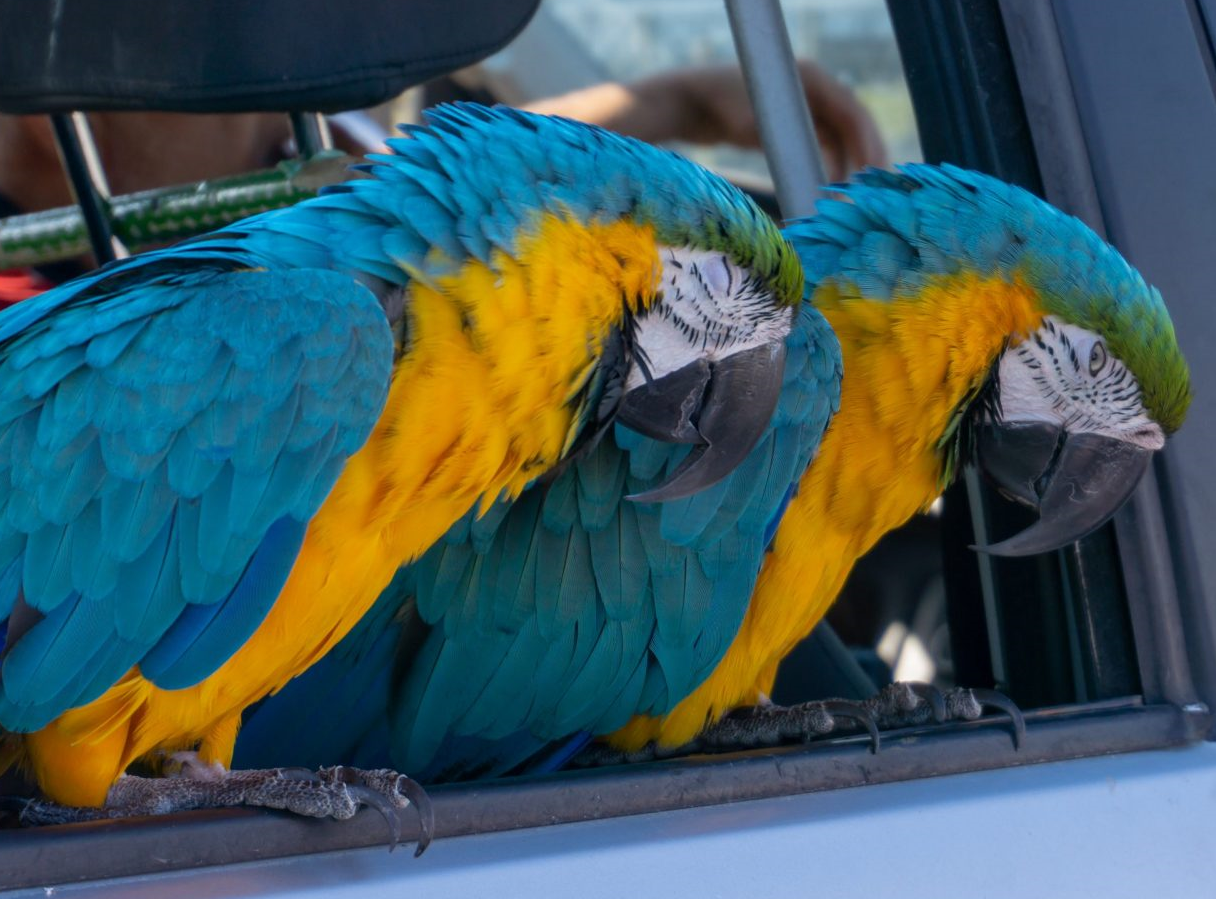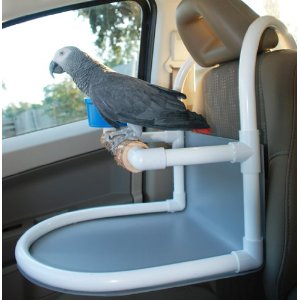Table of Contents
The Struggle with Picky Parrots
Ever feel like your parrot is a picky eater? You're not alone! Parrots in the wild are super careful about what they eat because some plants are poisonous. This instinct can make it hard to get them to try new foods at home. But don't worry, we've got some fun tips to help you teach your parrot to love healthy foods!
Why Parrots Are Picky Eaters
Parrots are social birds and learn what to eat from their flock. At home, you're their flock!
Show your parrot what to eat by enjoying healthy foods together. Use positive reinforcement, like treats or praise, when they try new foods. They'll soon learn that healthy foods are delicious!
Teaching Your Parrot to Eat Healthy
Parrots learn by watching and mimicking. You can use this to teach them to eat healthy. Start by offering the same fruits and veggies you eat. Remember the avian food pyramid for guidance. You can find it here.
Techniques for Introducing New Foods
There are a few methods to help your parrot transition to healthier foods. Here are three proven techniques based on the research "An Evaluation of Three Diet Conversion Methods in Psittacine Birds Converting from Seed-Based Diets to Pelleted Diets" by Cummings, Hess, Spielvogel, and Kottwitz (2022)
Birdies Choice
This method is all about choice and reward.
Place three different types of healthy foods on a table. If your parrot shows interest or eats any of them, give them a treat.
Gradually start adding the chosen food to their regular meals.
How Birdies Choice Works
Encourage Interaction: Tap around the foods or use a mirror to make it seem like another bird is eating.
Reward: Praise your parrot when they show interest or eat the food.
Gradual Transition: Slowly replace their regular food with the chosen healthy food.
Slow and Steady
In this method, alternate between the new healthy food and their usual food. Start with small amounts of the new food and gradually increase it. This helps your parrot get used to the new tastes and textures.
How Slow and Steady Works
Morning: Offer only the new healthy food for four hours.
Afternoon: If needed, offer a small amount of their usual food in a separate bowl.
Evening: Remove the usual food and leave the healthy food overnight.
Daily Refresh: Keep the new food available at all times and refresh daily.
Tough Love
This method is more direct. Offer the new food multiple times a day and only give a small portion of their usual food. This maximizes their exposure to the new food. It can be challenging, but it’s very effective.
How Tough Love Works
Limited Usual Food: Offer a small portion of their usual food in a less preferred location.
Daily Rationing: Gradually reduce the amount of usual food and remove it entirely after a few days.
Midday Treat: Offer a favorite treat coated with the new food to encourage positive interaction.
Making Feeding Time Fun
Feeding your parrot can be a fun bonding experience. Use colorful fruits and veggies to make meals exciting. Try arranging the food in fun shapes or using foraging toys to hide healthy treats. This not only makes feeding time fun but also stimulates their natural foraging instincts.
Fun Feeding Ideas
Colorful Plates: Use a variety of colorful fruits and veggies.
Food Art: Arrange the food in fun shapes or patterns.
Foraging Toys: Hide treats in foraging bird toys to make eating an adventure.
Safe, Fresh Foods for Parrots
Spring and summer bring a bounty of fresh fruits and veggies. Look for organic options at your local market. Berries, melons, and tropical fruits are delicious choices. Don’t forget veggies like bell peppers, carrots, and leafy greens.

Seasonal Fresh Foods
Spring and Summer: Berries, melons, tropical fruits, and fresh greens.
Year-Round: Root vegetables, beans, and sprouted seeds and grains.
Offering your parrot a rich variety of foods is essential to ensure they get all the nutrients they need to grow beautiful feathers. Just like us, parrots thrive on a diverse diet that includes different fruits, vegetables, grains, and proteins.
By mixing up their meals, you not only keep feeding time interesting but also make sure they receive a balanced intake of vitamins, minerals, and other vital nutrients. This variety supports their overall health, boosts their immune system, and keeps their feathers vibrant and shiny. So, get creative with their menu and watch your parrot flourish!

Print This Chart
Unsafe Foods That You Should Avoid
Here are some foods that are unsafe and should not be fed to your bird. Please note that this list may not be comprehensive:
- Avocado
- Chocolate
- Caffeine
- Alcohol
- Salty foods
- Onion and garlic
- Apple seeds
- Stone fruit pits (e.g., cherry, peach, plum)
- Rhubarb leaves
- Mushrooms
- Tomato leaves and stems
- High-fat, high-sugar, and processed foods
- Dairy products (in large quantities)
- Foods with artificial sweeteners (especially xylitol)
- Uncooked beans
Changing Your Parrot's Diet Gradually
When switching your parrot to a new diet, take it slow. Birds need time to learn that new foods are safe. Introduce one new food at a time and mix it with their usual diet. Keep track of their preferences and adjust as needed.
Steps to Gradual Diet Change
Introduce Slowly: Add small amounts of new food to their usual diet.
Mix and Match: Mix new foods with familiar ones.
Monitor Preferences: Observe what they like and dislike.
Consulting with a Bird Behaviorist
If you're unsure about how to train your parrot to eat a healthier diet, consult a bird behaviorist. They can provide tailored advice to ensure your parrot is getting all the nutrients they need. Regular check-ups with a behaviorist are important to monitor your bird's eating habits and overall well-being.
Consulting a bird behaviorist offers tailored advice, creating personalized diet plans that meet your parrot's specific needs. Regular check-ups ensure their diet stays balanced and their health is monitored. Plus, you'll receive expert tips on diet and behavior to keep your parrot happy and healthy. This specialized support can transform feeding time into a fun, stress-free experience for both of you.
Conclusion
Getting your parrot to eat healthy can be a fun and rewarding experience. By being patient and using these techniques, you can help your parrot enjoy a balanced diet. Remember, you’re their flock, and they learn by watching you. Make feeding time a joyful and engaging activity for both of you.
Test Your Knowledge!
Quiz: Test Your Knowledge on Parrot Nutrition and Feeding Techniques
Share your healthy bird diet journey in the comments below
Related Posts:
Cracking The Cockatoo Diet Puzzle: Tips For A Healthy Pet
Discover The Optimal African Grey Diet And Help Your Bird Thrive!
Forage to Flourish: Revamping Your Cockatiel's Diet
Healthy Bird Food
About Harrison's Bird Food
Why Feed Goldenfeast Bird Food
References:
Budai, K and Pao, S. A Parrot's Fine Cuisine Cookbook & Nutritional Guide. Quietlight Productions, No. Palm Springs, CA. 2018.
Cummings, A. M., Hess, L. R., Spielvogel, C. F., & Kottwitz, J. J. (2022). An evaluation of three diet conversion methods in psittacine birds converting from seed-based diets to pelleted diets. Journal of Avian Medicine and Surgery, 36(2), 145-152.Hoppes, S. M., (2018) Reproductive Diseases of Pet Birds. Merck Veterinary Manual (online).
Ritzman, T., (2008) Practical Avian Nutrition (Proceedings). CVC In San Diego. Lenexa: UBM Animal Care.
Link to this blog
Burroughs, D. (2024, July 2). How to get your bird to eat healthy bird food. Retrieved from https://birdsupplies.com/blogs/news/158154311-what-fresh-foods-are-safe-for-parrots
We’d love to hear about your journey in getting your parrot to eat healthy. Share your stories and tips in the comments below!
Diane Burroughs, LCSW is a licensed psychotherapist trained in ABA therapy techniques. She specializes in avian anxiety disorders and is certified in Nutrition For Mental Health. Diane has written a number of bird behavior books and she offers behavior consultations. She's developed a range of UnRuffledRx Science-backed Parrot Wellness Supplies.
Diane's products have been featured in the Journal of Avian Medicine and Surgery and at ExoticsCon, a conference for exotic pet veterinarians. Her bird collars & supplements are stocked in avian vet clinics and bird stores throughout the US. With over 30 years in the field of behavior, Diane has created thousands of successful individualized behavior plans that help pets thrive.
TAGS: #HealthyBirdFood #BirdNutrition #ParrotDiet #HowToGetYourBirdToEatVegetables #FreshFoodForBirds #ParrotHealth #BirdFeedingTips #ParrotCare
SHARING IS CARING! PLEASE SHARE ON YOUR FAVORITE SOCIAL MEDIA NOW!










